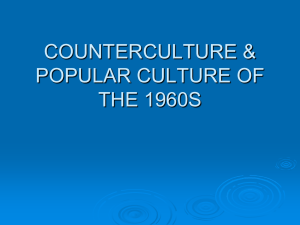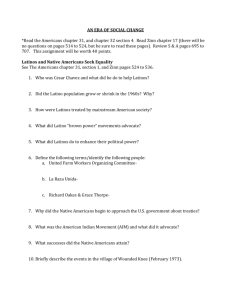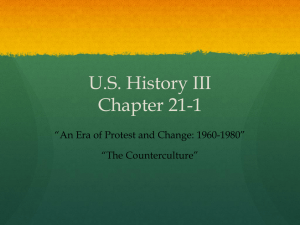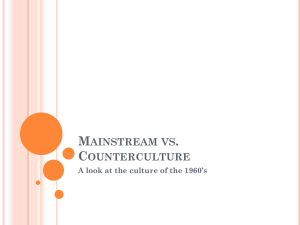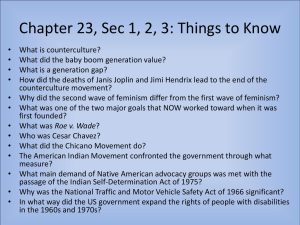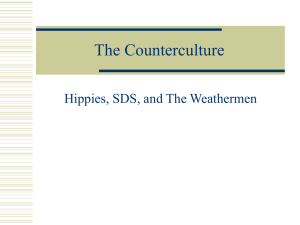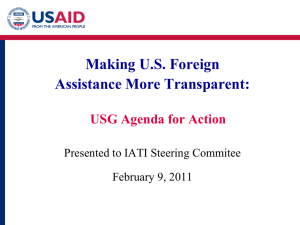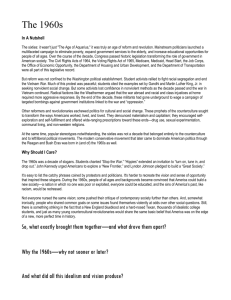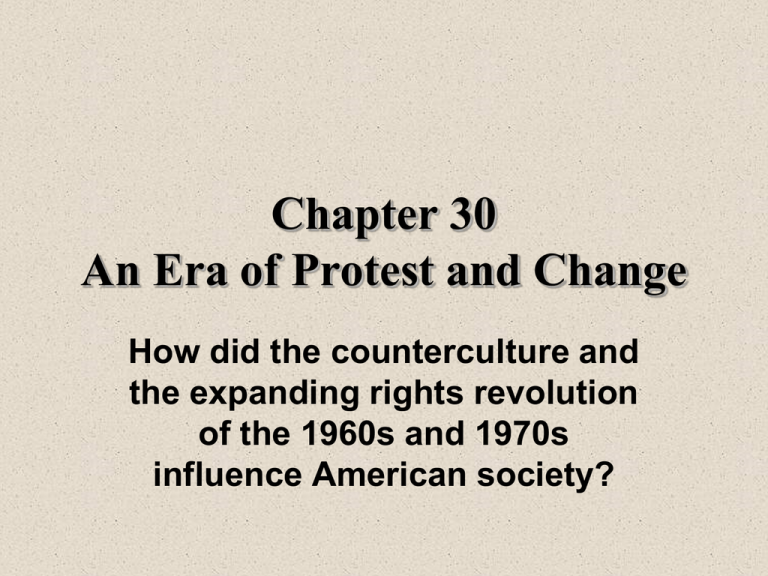
Chapter 30
An Era of Protest and Change
How did the counterculture and
the expanding rights revolution
of the 1960s and 1970s
influence American society?
Standards
•
•
•
•
•
•
•
•
•
•
•
•
SSUSH24
The student will analyze the impact of social change movements and organizations of
the 1960's.
Element: SSUSH24.a
Compare and contrast the Student Non-Violent Coordinating Committee (SNCC) and
the Southern Christian Leadership Conference (SCLC) tactics, including sit-ins,
freedom rides, and changing composition.
Element: SSUSH24.b
Describe the National Organization of Women and the origins and goals of the modern
women's movement.
Element: SSUSH24.c
Analyze the anti-Vietnam War movement.
Element: SSUSH24.d
Analyze Cesar Chavez and the United Farm Workers movement.
Element: SSUSH24.e
Explain Rachel Carson and Silent Spring, Earth Day, the creation of the EPA, and the
modern environmentalist movement.
The Counterculture
Section 1
• What was the counterculture and
what impact did it have on American
society?
• Vocabulary:
-counterculture
-generation gap
-Beatles
commune
Haight-Ashbury
Timothy Leary
The Counterculture
The Counterculture Rises
Main Idea: In the 1960s, a counterculture of hippies developed. The
hippies valued youth, spontaneity, freedom of expression, and
experimentation with styles very different from those
of the previous generation.
Defining the Counterculture
Main Idea: The counterculture was shaped by rock-and-roll music, the
sexual revolution, experimenting with drugs, unconventional clothing,
and new religious and political beliefs.
The Counterculture Ends
Main Idea: Most hippies became disillusioned with the counterculture
and began to merge
back into mainstream culture by the end of the 1960s.
The Counterculture
• Valued youth, spontaneity, and freedom of
expression
• “Don’t trust anyone over 30”
• Experimented with
new styles of dress
and music, free sex,
and drugs
Youth Culture
• Culture that promoted freedom and individuality;
communes
• New Attitudes about relationships, drugs, and
music
• Sexual revolution
• New attitudes toward religion
• Deaths of Janis Joplin, Jim Morrison, and Jimi
Hendrix
• Beatles
Woodstock
Jimi Hendrix
Janis Joplin
Jim Morrison
NOTE TAKING
Reading Skill: Identify Main Ideas
TRANSPARENCY
Changing Fashions
INFOGRAPHIC
The Generation Gap
PM
TRANSPARENCY
Progress Monitoring Transparency
The Women’s Rights Movement
Section 2
• What led to the rise of the women’s
movement and what impact did it
have on American society?
• Vocabulary:
-feminism
Gloria Steinem
-Betty Friedan
Phyllis Schlafly
-NOW
Roe v. Wade
-Equal Rights Amendment (ERA)
The Women’s Rights Movement
A Women’s Movement Arises
Main Idea: There was a rebirth of the women’s movement as
women strove to redefine how they were viewed by society
and to gain more career opportunities.
Women Find Their Voices
Main Idea: The National Organization for Women was
established to fight discrimination and lobby for reforms.
Lasting Effects of the Women’s Movement
Main Idea: Feminists began to make legal advances,
including legislation that legalized abortion and prevented
discrimination in the workplace.
Background of the Women’s
Movement
• World War II – more women worked
• 1950s - many women stayed home
• By 1970, 41% of college students were
women
• Women earned less and were not
promoted to upper management
Impact of the Civil Rights
Movement
• Civil rights provided a model for
techniques
• Civil Rights Act of 1964 – gave women
right to sue for job discrimination
• Equal Employment Opportunity
Commission was slow to push women’s
claims
NOTE TAKING
Reading Skill: Identify Causes and Effects
Women’s Groups
• Betty Friedan – The
Feminine Mystique
• Felt women could not
achieve their full
potential
• Took part in
establishing NOW –
National
Organization for
Women
Impact of Feminism
• Literary Impact – Ms. Magazine – Gloria
Steinem
• Shift in attitudes – some women did not
participate
• Roe v. Wade – constitutional right to
personal privacy
• Equal Rights Amendment – make
discrimination on account of sex illegal
Opposition to the Women’s
Movement
• Phyllis Schlafly – led
campaign to block
ratification of the
ERA
• Many men were
hostile
• Some women hostile
TRANSPARENCY
The Equal Rights Amendment
COMPARING
VIEWPOINTS
Do Women Need to Fight for Equal Rights?
CHART
Women in the Workforce, by Age
PM
TRANSPARENCY
Progress Monitoring Transparency
The Rights Revolution Expands
Section 3
• How did the rights movements of the
1960s and 1970s expand rights for
diverse groups of Americans?
• Vocabulary:
-Cesar Chavez
Chicano movement
-migrant farmworker Ralph Nader
-United Farm Workers (UFW)
-American Indian Movement (AIM)
The Rights Revolution Expands
The Latino Population Grows
Main Idea: The need for laborers led to changing immigration laws and a sharp
increase in the number of Mexicans and other Latinos entering the United States.
Pressing for Equal Rights
Main Idea: In the 1960s, Latinos pressed for an end to discrimination in the
workplace, schools, housing, and voting rights.
Native Americans and Asian Americans Battle Discrimination
Main Idea: Native Americans were inspired by the growing civil rights movement
to expand their own push for new rights during the 1960s. At this same time,
Asian Americans battled against a long history of discrimination.
New Rights for Consumers and the Disabled
Main Idea: Building on ideas first raised during the Progressive Era, new laws
were passed protecting consumers and mandating workplace safety regulations.
During this time, the government also began exploring ways to help people with
disabilities.
“Ethnic Minorities Seek Equality”
• Latino or Hispanic
Population – family
origins are in
Spanish-speaking
Latin America
• Chicanos – Mexican
Americans
• Problems with
education
Cesar Chavez
• Helped migrant farm
workers
• Organized Mexican
workers into the
United Farm
Workers (UFW)
• Boycott of grapes to
gain consumer
support
CHART
United States Latino Population
CHART
Migrant Farmworkers Today
TRANSPARENCY
The Latino Movement
Asian Americans
• Japanese Americans
– want compensation
for losses from 1940s
• Japanese American
Citizens League
(JACL)
• 1988 Congress
apologizes and pays
money
NOTE TAKING
Reading Skill: Compare and Contrast
“Native American Struggles”
• Snyder Act of 1924 –
granted citizenship to
Native Americans
• Late getting the right
to vote
• Suffered from
poverty,
unemployment,
alcoholism, and
suicide
Native American Activism
• Land Claims – Seneca lost land for a dam
• Lawsuits filed to recover land
• Leaders of the Indian Movement
Dennis Banks and George Mitchell
• Organized the American Indian
Movement (AIM)
• Wanted autonomy or self-government
Confrontation
• Broken Treaties
Caravan – groups
traveled to
Washington and
occupied the Bureau
of Indian Affairs for
six days
• Occupation of
Alcatraz
Wounded Knee
• 1973 Pine Ridge
reservation
• Russell Means and
Dennis Banks with
200 AIM members
took over
• Government agreed
to examine treaties
Outcome
• Kennedy and Johnson administrations tried to
bring jobs and income by encouraging industry
to locate on reservations
• Indian Education Act of 1972 – gave more
control over schools
• Indian Self-Determination Act of 1974 –
autonomy
• Some tribes won legal battles for money and
land
Consumer Movement
• Ralph Nader –
Unsafe at Any Speed:
The Designed-in
Dangers of the
American Automobile
• “Nader’s Raiders”
NOTE TAKING
Reading Skill: Identify Causes
PM
TRANSPARENCY
Progress Monitoring Transparency
The Environmental Movement
Section 4
• What forces gave rise to the
environmental movement, and what
impact did it have?
• Vocabulary:
-Rachel Carson
Clean Air Act
-toxic waste
Clean Water Act
-Earth Day
EPA
-Endangered Species Act
The Environmental Movement
Environmental Activists Speak Out
Main Idea: Scientists began learning about
environmental threats, leading to environmental
activism and government legislation protecting the
earth.
Environmental Setbacks
Main Idea: Hazardous waste mishaps and accidents
involving nuclear energy led to further government
regulation of the environment, but many Americans
complained about too much control.
NOTE TAKING
Reading Skill: Recognize Sequence
“The Environmental Movement”
• Rachel Carson –
Silent Spring
• Attacked the use of
DDT and pesticides
• Public more
conscious of fumes,
oil spills, and toxic
wastes
• Earth Day April 22,
1970
Government Actions
• Environmental
Protection Agency
(EPA) 1970
• Set and enforce
national pollutioncontrol standards
• Clean Air Act
• Clean Water Act
Environmental Setbacks
• EPA investigates Love Canal: high rates of
birth defects and cancer caused by toxic
waste
• Congress established a Superfund to
clean up hazardous waste
CHART
Superfund Cleanup, 2004
Nuclear Power
• Plants to generate
electricity
• Less air pollution, but
steam killed fish
• Worry about nuclear
accidents
• Nuclear Regulatory
Commission (NRC)
TRANSPARENCY
Three Mile Island
PM
TRANSPARENCY
Progress Monitoring Transparency

